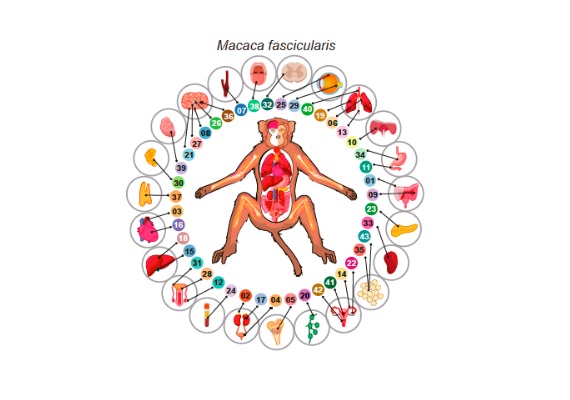Nature: International Team Led by BGI Completes First Whole-Body Cell Atlas of a Non-Human Primate
The research will provide insights into the development of potential treatments for neurological diseases and obesity, among other human conditions
In a breakthrough that could lead to scientific advancement in the treatment of human diseases, researchers from BGI-Research, Jilin University and the Guangzhou Institutes of Biomedicine and health (Chinese Academy of Sciences), together with scientific research teams from 35 international institutions including China, Germany, Italy, Singapore, Spain, Sweden and the UK, today published the world’s first non-human primate whole-body cell transcriptomic atlas in the scientific journal Nature. The study, “Cell transcriptomic atlas of the non-human primate Macaca fascicularis”, obtained ethical clearance before it was conducted.
By using BGI’s independently-developed DNBelab C4 single-cell library sequencing platform, the researchers completed the single-cell transcriptome of 45 tissues and organs from long-tailed macaque (cynomolgus) monkeys, obtaining a total of 1.14 million single-cell data and identifying 113 major cell types.
This study and other large scale primate research at the single-cell level are only possible through developments in advanced sequencing technology, an area where BGI is a leader. BGI’s proprietary technology enables extensive and multi-dimensional single-cell analysis with high sensitivity and accuracy at a low cost.
Non-human primates such as macaques are the species closest to humans in the evolutionary tree. By mapping the macaque transcriptome at the single-cell level, scientists now have a database, or single-cell library, that can be used for
- developing methods for disease diagnosis and treatment,
- assessment of clinical drug efficacy,
- analysis of cell evolution among species, and
- analysis of advanced cognitive functions of the brain.
Single-cell mapping allowed the team to identify the cell types that may contribute to human disease or make individuals more susceptible to the disease. For example, in COVID-19, the biggest manifestation is pneumonia because SARS-CoV-2 infects a small group of cells in the lung. However, the single-cell mapping of macaque also identified certain cells in other tissues that can become infected in primates. This can help doctors understand where to look for signs of COVID-19.
Single-cell mapping can also help identify which cells metabolize calories from fat, allowing researchers to comprehend underlying contributors to obesity. Likewise, this process could help identify which cells regulate neuronal circuits in the brain, leading to potential treatments for neurological diseases.
“Single-cell research is transforming our understanding of tissue and organ functions at a cellular level, which informs how diseases develop and how they can be treated” and “having a whole-body organ single-cell map of the adult macaque will significantly improve the ability to pinpoint how to develop potential treatments for human diseases with greater precision” said Dr. Liu Longqi from BGI-Research, one of the corresponding authors of the paper.
“By understanding cell types and their characteristics, scientists will be able to predict the impact of disease treatments on specific cell structures and thus develop more targeted approaches for monogenic or complex genetic diseases” said co-corresponding author Dr. Xu Xun, director of BGI-Research.
“This study fills the gap of the single-cell map of non-human primates and is a rich data resource that will serve as a very important reference for future species evolution, brain science, drug evaluation and screening, and preclinical research studies” said another co-corresponding author, Dr. Miguel A. Esteban from Jilin University and the Guangzhou Institutes of Biomedicine and Health (Chinese Academy of Science.
- Han, L., Wei, X., Liu, C., Volpe, G., Zhuang, Z., Zou, X., Wang, Z., Pan, T., Yuan, Y., Zhang, X., Fan, P., Guo, P., Lai, Y., Lei, Y., Liu, X., Yu, F., Shangguan, S., Lai, G., Deng, Q., … Liu, L. (2022). Cell transcriptomic atlas of the non-human primate Macaca fascicularis. Nature, 1-9. https://doi.org/10.1038/s41586-022-04587-3











